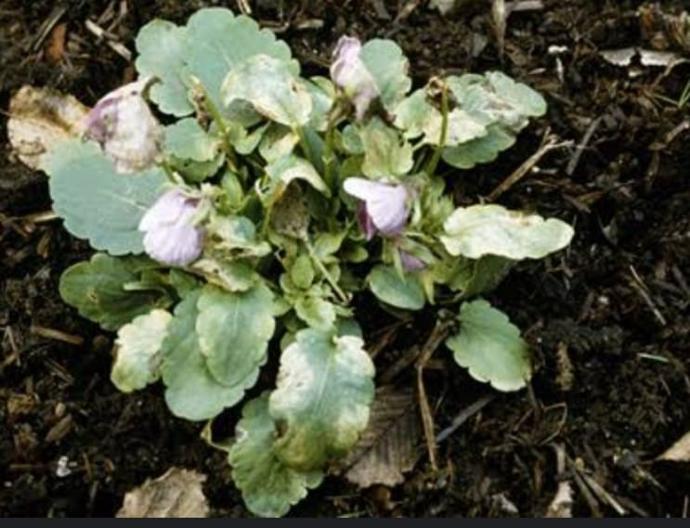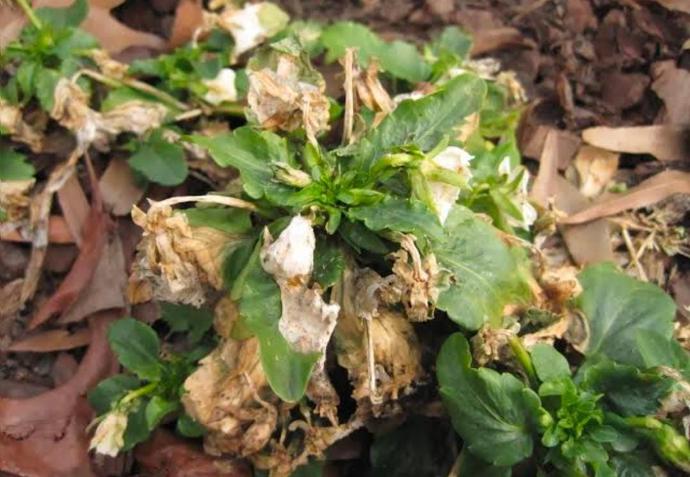Pansy Plant
Pansy, also known as Viola tricolor, is an outdoor flowering plant. Plant in well-draining soil with full sun to partial shade. Water consistently and deadhead spent flowers for continuous blooming. Pruning helps maintain a compact and bushy appearance.
Habit
Perennial
Height
15-25 cm
Growth
Moderate
Soil
Well-drained, fertile
Shade
Partial shade to Full Sun
Moisture
Moist
Edible
No
Medicinal
No
Origin
Europe, Asia
Climatic Condition
Temperate
Temperature (°)
10-20°C
Humidity (%)
60-80%
Potting media
Loamy, peat
Fertilizers
Balanced NPK (10-10-10)
Watering
Regular, moderate
Plant Weight
100-200 g
Flowering Time
Spring, Fall
Soil Ph level
6.0 - 7.0
Water Ph level
6.5 - 7.5
Soil EC
1-2 dS/m
Yield Per Plant
Ornamental (flowers)
NPK ratio
10:10:10
life Span
Annual
Health Benefits
Ornamental, mild pain relief properties
Suggested Grow Media or Potting Mix ?
50% loamy soil, 30% compost, 20% sand
Suggested Fertigation/Fertilizers
Fertilize every 4 weeks with a balanced, water-soluble fertilizer.
Common Diseases and Remedies
Gray mould, Botrytis cinerea
Become flecked and rotten, Grey-brown lesions occur n leaves.
Vinegar, Neem oil.
HEALTH BENEFITS
· Rich in antioxidants and flavonoids, supporting skin and heart health.
· Has anti-inflammatory and antibacterial properties.
· Traditionally used to treat respiratory infections and skin conditions.
· Helps with wound healing and soothes irritation.
What Is An Pansy?
Pansy plants are popular garden flowers known for their colorful blooms and hardiness. They belong to the genus Viola and come in a variety of colors including purple, yellow, white, and orange. Pansies are often planted in cool weather and can tolerate some frost, making them a great choice for early spring and fall gardens. They require well-drained soil and regular watering to thrive.

What Are The Different Types Of Pansy?
1. Delta Series
Known for their large, vibrant flowers and compact growth habit, the Delta series pansies come in a wide range of colors.
2. Majestic Giant Series
These pansies produce exceptionally large flowers, often reaching up to 4 inches in diameter, and they come in various colors.
3. Matrix Series
Matrix pansies are known for their early and prolific flowering, compact growth, and wide color range.
4. Cool Wave Series
This trailing pansy variety is ideal for hanging baskets and containers, with its vigorous growth and abundant blooms.
5. Frizzle Sizzle Series
Frizzle Sizzle pansies feature uniquely ruffled petals, giving them a distinctive appearance in the garden.

How To Care For Pansy?
1. Location
Pansy plants are typically grown in cool, temperate climates. They prefer full to partial sunlight and well-drained soil with a pH level between 5.4 and 5.8. They can tolerate some shade, especially in warmer regions. Pansies are often used in flower beds, borders, containers, and hanging baskets. They are commonly planted in early spring or fall, as they thrive in cooler temperatures and can withstand light frost.
2. Sunshine
Pansy plants prefer full to partial sunlight. They generally thrive in areas where they receive at least 4-6 hours of sunlight per day. However, in warmer climates, they may benefit from some shade during the hottest part of the day to prevent wilting and scorching of their delicate flowers and foliage.
3. Soil
Pansy plants prefer well-drained, fertile soil that is rich in organic matter. A loamy soil with good drainage is ideal for pansies. It's important to avoid soils that are too compacted or waterlogged, as this can lead to root rot and other issues. Adding compost or well-aged manure to the soil before planting can improve its fertility and drainage. Additionally, maintaining a slightly acidic soil pH between 5.4 and 5.8 is optimal for pansy growth and flower production.
4. Hydration
Pansy plants require regular watering to keep the soil consistently moist but not waterlogged. It's important to water them deeply, ensuring that the root zone is adequately hydrated. Allow the soil to dry slightly between waterings, as pansies do not like to sit in soggy soil. During hot and dry periods, pansies may need more frequent watering to prevent wilting. Applying a layer of mulch around the base of the plants can help retain soil moisture and regulate temperature.

5. Nourishment
Use a balanced fertilizer with equal parts nitrogen, phosphorus, and potassium (N-P-K) or a fertilizer specifically formulated for flowering plants. Apply the fertilizer according to the instructions on the label, typically every 2-4 weeks during the growing season.Incorporate organic matter such as compost or well-aged manure into the soil before planting to improve soil fertility and texture.
6. Issues
fungal disease that appears as a white powdery substance on the leaves, powdery mildew can weaken the plant and affect its growth and flowering.These small, soft-bodied insects feed on the sap of pansy plants, causing distorted growth, yellowing leaves, and reduced flowering. They can also transmit viral diseases.Overwatering or poorly drained soil can lead to root rot, which causes the roots to become mushy and decayed. Affected plants may wilt, yellow, or collapse.
What Are The Benefits Of Pansy
Colorful Blooms Pansies produce vibrant, eye-catching flowers in a wide range of colors, adding beauty and charm to gardens, containers, and landscape beds. Long Blooming Season Pansies are known for their long blooming season, providing color from early spring to late fall in many regions. Versatility Pansies can be used in various ways, including as bedding plants, edging plants, container plants, and hanging basket fillers, making them versatile choices for gardeners. Attracts Pollinators: Pansy flowers attract pollinators such as bees and butterflies, helping to support local ecosystems and promote biodiversity in the garden.

FAQs About Growing Pansy
1. Where are pansies native to?
Pansies are native to Europe and western Asia. They were first cultivated in the early 19th century and have since been widely hybridized to produce the colorful varieties commonly seen in gardens today.
2. How long do pansy plants typically live?
Pansy plants are typically considered annuals or short-lived perennials. In most cases, they are grown as annuals, meaning they complete their life cycle within one growing season and then die off. However, in some climates with mild winters, pansies may survive and bloom again the following year, acting as short-lived perennials. Generally, pansies grown as annuals will live for one growing season, while those grown in favorable conditions may persist for a few years.
3. When is the best time to plant pansies?
The best time to plant pansies depends on your climate and local growing conditions. In general, pansies are cool-season plants, so they are typically planted in early spring or fall when temperatures are cooler.
4. What colors do pansy flowers come in?
Pansy flowers come in a wide array of colors, offering gardeners a rich palette to choose from.Purple, Yellow, White, Blue, Orange, Lavender. Bi-color combinations, such as purple and yellow, blue and white, or red and yellow
5. Can pansies survive winter temperatures?
Pansies are generally considered cool-season annuals, meaning they thrive in cooler temperatures but may struggle with prolonged exposure to freezing temperatures. However, pansies can often survive mild winters and light frosts, especially if they are well-established and have been properly cared for.

